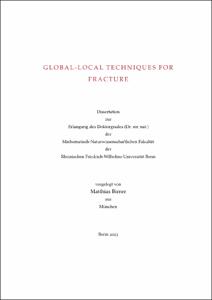Birner, Matthias: Global-Local Techniques for Fracture. - Bonn, 2023. - Dissertation, Rheinische Friedrich-Wilhelms-Universität Bonn.
Online-Ausgabe in bonndoc: https://nbn-resolving.org/urn:nbn:de:hbz:5-73449
Online-Ausgabe in bonndoc: https://nbn-resolving.org/urn:nbn:de:hbz:5-73449
@phdthesis{handle:20.500.11811/11201,
urn: https://nbn-resolving.org/urn:nbn:de:hbz:5-73449,
doi: https://doi.org/10.48565/bonndoc-188,
author = {{Matthias Birner}},
title = {Global-Local Techniques for Fracture},
school = {Rheinische Friedrich-Wilhelms-Universität Bonn},
year = 2023,
month = dec,
note = {In the numerical simulation of components and structures it is necessary to incorporate the effect of localized damage and its propagation. However, simulating fracture on top of linear elasticity in three space dimensions significantly increases the computational cost. The need to choose a law to predict the crack path introduces further modeling decisions that are still an open research topic. Other approaches such as the phase-field method or peridynamics handle fracture naturally but are even more expensive to simulate. In this thesis, we demonstrate how the global-local enrichments method can improve this by either separating the degrees of freedom required for the resolution of the crack, or by moving a whole expensive method onto a different, local discretization whose solution is then used as a basis function on the global problem. To this end, we use the flat-top ac{PUM} due to its flexibility in the application of enrichments.
Specifically, this thesis contributes the following. First, we bring the simulation of three-dimensional fracture to the ac{PUM}. We address the challenges introduced by complex crack geometries and validate our implementation in numerical experiments. Second, we adapt the global-local enrichments method, such that its parallelization opportunity can be exploited efficiently with the flat-top cover construction in the ac{PUM}. We evaluate the accuracy, parallel scaling and performance of the resulting method in numerical experiments in three space dimensions. Parallel scaling of the resulting method is excellent and especially weak scaling is optimal. It further achieves the same accuracy as applying the degrees of freedom from the local problem directly on the global problem. The global-local method is thus a viable alternative for direct h-refinement in the simulation of fracture. Lastly, we generalize the global-local method to a coupling method that allows the flexible combination of the ac{PUM} with different simulation frameworks. Here, we present numerical results with peridynamics and the phase-field method on the local problem, which serve as a crack growth law for the global linear elasticity simulation. The global-local coupling approach produces similar results as traditional direct coupling along an interface and the obtained crack paths are in good agreement with real world experimental data.},
url = {https://hdl.handle.net/20.500.11811/11201}
}
urn: https://nbn-resolving.org/urn:nbn:de:hbz:5-73449,
doi: https://doi.org/10.48565/bonndoc-188,
author = {{Matthias Birner}},
title = {Global-Local Techniques for Fracture},
school = {Rheinische Friedrich-Wilhelms-Universität Bonn},
year = 2023,
month = dec,
note = {In the numerical simulation of components and structures it is necessary to incorporate the effect of localized damage and its propagation. However, simulating fracture on top of linear elasticity in three space dimensions significantly increases the computational cost. The need to choose a law to predict the crack path introduces further modeling decisions that are still an open research topic. Other approaches such as the phase-field method or peridynamics handle fracture naturally but are even more expensive to simulate. In this thesis, we demonstrate how the global-local enrichments method can improve this by either separating the degrees of freedom required for the resolution of the crack, or by moving a whole expensive method onto a different, local discretization whose solution is then used as a basis function on the global problem. To this end, we use the flat-top ac{PUM} due to its flexibility in the application of enrichments.
Specifically, this thesis contributes the following. First, we bring the simulation of three-dimensional fracture to the ac{PUM}. We address the challenges introduced by complex crack geometries and validate our implementation in numerical experiments. Second, we adapt the global-local enrichments method, such that its parallelization opportunity can be exploited efficiently with the flat-top cover construction in the ac{PUM}. We evaluate the accuracy, parallel scaling and performance of the resulting method in numerical experiments in three space dimensions. Parallel scaling of the resulting method is excellent and especially weak scaling is optimal. It further achieves the same accuracy as applying the degrees of freedom from the local problem directly on the global problem. The global-local method is thus a viable alternative for direct h-refinement in the simulation of fracture. Lastly, we generalize the global-local method to a coupling method that allows the flexible combination of the ac{PUM} with different simulation frameworks. Here, we present numerical results with peridynamics and the phase-field method on the local problem, which serve as a crack growth law for the global linear elasticity simulation. The global-local coupling approach produces similar results as traditional direct coupling along an interface and the obtained crack paths are in good agreement with real world experimental data.},
url = {https://hdl.handle.net/20.500.11811/11201}
}






